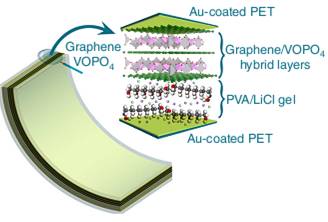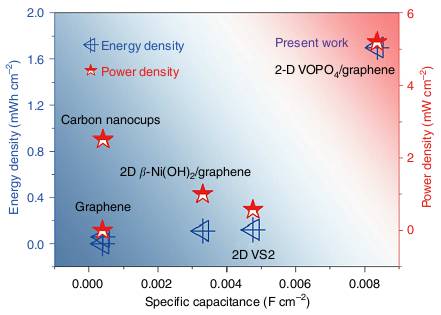Recently, breakthrough in 2D graphene analogues research have been achieved by the co-efforts of Prof. XIE Yi's research group, from University of Science and Technology of China, and Prof. YU Guihua's team, from the University of Texas at Austin. The newly discovered material makes the flexible ultrathin-flim supercapacitors in all-solid-state with high redox potential and high energy density possibly into practice.
A rapidly growing demand for portable consumer electronics has greatly promoted the development of flexible energy devices in all-solid-state. As the future generation energy storage device, the flexible thin-film supercapacitor in all-solid-state (FUSA) offers the synergic benefits of flexibility, thinness and transparency. Two-dimensional (2D) graphene-like materials with pseudocapacitive characteristics represents a promising direction to accomplish the flexible ultrathin-film pseudocapacitor in all-solid-state (FUPA) with higer energy density, and potentially excellent mechanical flexibility. But the energy density of graphene-like materials need to be promoted. Therefore, the discovery of new graphene-like pseudocapacitive materials with enhacnced electrochemical performance is much needed for constructing FUSA with higher power and energy densities, vital for satisfying the practical applications.

Fig. 1. Schematic illustration of an as-fabricated flexible ultrathin-film pseudocapacitor, in which the VOPO4/graphene hybrid layers function as the working electrode and PVA/LiCl gel functions as the electrolyte.
Here the researchers reported 2-2-propanol-assisted ultrasonicationmethod to effectively exfoliate bulk VOPO4·2H2O into VOPO4 ultrathin nanosheets, with a thickness of less than six atomic layers, as a new graphene-like material. To fully explore theelectrochemical performance of VOPO4, a VOPO4/graphene hybrid film was layer-by-layer assembled to achieve both high planar conductivity and superior electrochemical performance. The FUPA based on the VOPO4/graphene hybrid thin film demonstrated a high output voltage, a large specific capacitance and a high energy density, opening up opportunities for exploring new quasi-2D materials for flexible energy device with higher energy density. The material exhibits a high potential plateau of ~1.0 V in aqueous solutions, approaching the electrochemical potential window of water (1.23 V). The as-established flexible supercapacitor achieves a high redox potential (1.0 V), long cycle life (more than 2,000 cycles) and a high areal capacitance of 8,360.5 μF cm-2 (the highest value among reported FUSAs), leading to a highest among reported energy density of 1.7 mWh cm-2 and a power density of 5.2 mW cm-2.

Fig. 2. Performance comparison of various materials. Our FUPA based on 2D VOPO4/graphene hybrid thin film showing the best performance of energy density compared with the reported flexible ultrathin-film supercapacitors in all-solid-state for graphene, carbon nanocups, Ni(OH)2 and 2D VS2.
The findings represent a promising direction and a significant step towards exploring new quasi-2D materials for flexible energy device with higher energy density in the near future.
The results were published in Nature Communications on Sept. 12th.
(ZHAO Xuemei, USTC News Center)